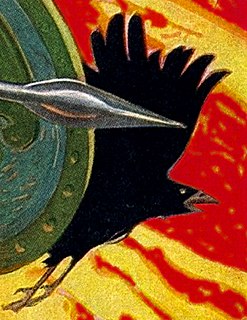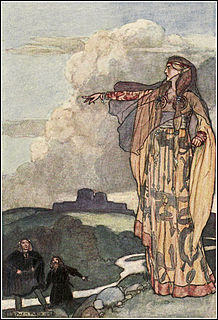Related Research Articles

Lugh or Lug is one of the most prominent gods in Irish mythology. A member of the Tuatha Dé Danann, Lugh is portrayed as a warrior, a king, a master craftsman and a savior. He is associated with skill and mastery in multiple disciplines, including the arts. He is also associated with oaths, truth and the law, and therefore with rightful kingship. Lugh is linked with the harvest festival of Lughnasadh, which bears his name. His most common epithets are Lámfada and Samildánach.

The Morrígan or Mórrígan, also known as Morrígu, is a figure from Irish mythology. The name is Mór-Ríoghain in Modern Irish, and it has been translated as "great queen" or "phantom queen".
Conn Cétchathach, son of Fedlimid Rechtmar, was, according to medieval Irish legendary and annalistic sources, a High King of Ireland, and the ancestor of the Connachta, and, through his descendant Niall Noígiallach, the Uí Néill dynasties, which dominated Ireland in the early Middle Ages, and their descendants.
Áine is an Irish goddess of summer, wealth and sovereignty. She is associated with midsummer and the sun, and is sometimes represented by a red mare. She is the daughter of Egobail, the sister of Aillen and/or Fennen, and is claimed as an ancestor by multiple Irish families. As the goddess of love and fertility, she has command over crops and animals and is also associated with agriculture.

Macha was a sovereignty goddess of ancient Ireland associated with the province of Ulster, particularly the sites of Navan Fort and Armagh, which are named after her. Several figures called Macha appear in Irish mythology and folklore, all believed to derive from the same goddess. She is said to be one of three sisters known as 'the three Morrígna'. Like other sovereignty goddesses, Macha is associated with the land, fertility, kingship, war and horses.
Scáthach, or Sgathaich, is a figure in the Ulster Cycle of Irish mythology. She is a legendary Scottish warrior woman and martial arts teacher who trains the legendary Ulster hero Cú Chulainn in the arts of combat. Texts describe her homeland as Scotland (Alpeach); she is especially associated with the Isle of Skye, where her residence Dún Scáith stands. She is called "the Shadow" and "Warrior Maid" and is the rival and sister of Aífe, both of whom are daughters of Árd-Greimne of Lethra.

Medb —later spelled Meadhbh and Méabh —is queen of Connacht in the Ulster Cycle of Irish mythology. Her husband in the core stories of the cycle is Ailill mac Máta, although she had several husbands before him who were also kings of Connacht. She rules from Cruachan. She is the enemy of Conchobar mac Nessa, king of Ulster, and is best known for starting the Táin Bó Cúailnge to steal Ulster's prize stud bull Donn Cúailnge.

The Hill of Tara is a hill and ancient ceremonial and burial site near Skryne in County Meath, Ireland. Tradition identifies the hill as the inauguration place and seat of the High Kings of Ireland; it also appears in Irish mythology. Tara consists of numerous monuments and earthworks—dating from the Neolithic to the Iron Age—including a passage tomb, burial mounds, round enclosures, a standing stone, and a ceremonial avenue. There is also a church and graveyard on the hill. Tara forms part of a larger ancient landscape and Tara itself is a protected national monument under the care of the Office of Public Works, an agency of the Irish Government.

County Meath is a county in Ireland. It is in the province of Leinster and is part of the Mid-East Region. It is named after the historic Kingdom of Meath. Meath County Council is the local authority for the county. At the 2016 census, the population of the county was 195,044. The county town of Meath is Navan. Other towns in the county include Trim, Kells, Laytown, Ashbourne, Dunboyne, Slane and Bettystown.
Saint Brigid of Kildare or Brigid of Ireland is one of Ireland's patron saints, along with Patrick and Columba. Irish hagiography makes her an early Irish Christian nun, abbess, and foundress of several monasteries of nuns, including that of Kildare in Ireland, which was famous and was revered. Her feast day is 1 February, which was originally a pagan festival called Imbolc, marking the beginning of spring. Her feast day is shared by Dar Lugdach, who tradition says was her student, close companion, and the woman who succeeded her.
Túathal Techtmar [ ˈtu:əθal ˈtʲɛxtwər ], son of Fíachu Finnolach, was a High King of Ireland, according to medieval Irish legend and historical tradition. He is said to be the ancestor of the Uí Néill and Connachta dynasties through his grandson Conn of the Hundred Battles. The name may also have originally referred to an eponymous deity, possibly even a local version of the Gaulish Toutatis.
Mongfind —meaning "fair hair" or "white hair"—is a figure from Irish legend. She is said to have been the wife, of apparent Munster origins, of the legendary High King Eochaid Mugmedón and mother of his eldest three sons, Brión, Ailill and Fiachrae, ancestors of the historical Connachta. She was Eochaid's first wife; his second wife, Cairenn, gave birth to Niall of the Nine Hostages. Several tales depict Mongfind as an adversary of Niall. Mongfind is also said to have been the sister of Crimthann mac Fidaig, King of Munster and the next High King of Ireland, whom she is said to have killed with poison in a bid to make her son king. She drank the poisoned drink to convince Crimthann, and died soon after at Samhain.
Mug Ruith is a figure in Irish mythology, a powerful blind druid of Munster who lived on Valentia Island, County Kerry. He could grow to enormous size, and his breath caused storms and turned men to stone. He wore a hornless bull-hide and a bird mask, and flew in a machine called the roth rámach, the "oared wheel". He had an ox-driven chariot in which night was as bright as day, a star-speckled black shield with a silver rim, and a stone which could turn into a poisonous eel when thrown in water.
O'Rahilly's historical model is a theory of the history of prehistoric Ireland in the Iron Age put forward by the linguist T. F. O'Rahilly in 1946. It was based on his study of the influences on the Irish language and a critical analysis of Irish mythology.

The Hill of Uisneach or Ushnagh is a hill and ancient ceremonial site in the barony of Rathconrath in County Westmeath, Ireland. It is a protected national monument. It consists of numerous monuments and earthworks—prehistoric and medieval—including a probable megalithic tomb, burial mounds, enclosures, standing stones, holy wells and a medieval road. Uisneach is near the geographical centre of Ireland, and in Irish mythology it is deemed to be the symbolic and sacred centre of the island. It was said to be the burial place of the mythical Tuatha Dé Danann, and a place of assembly associated with the druids and the festival of Bealtaine.

The Hill of Ward is a hill in County Meath, Ireland.
The stories of the rogue sorcerer Simon Magus and his consort Helen, which showcased the early battles between religion and magic, have often captured the imagination of artists and writers.

Summerhill is a designated heritage village in County Meath, Ireland. It is located at the intersection of the R156 and R158 regional roads and is part of the Laracor civil parish. The Irish version of the town's name means "Lynch's Hill", and it was the ancestral home of the Norman-Irish Lynch family, whence came the Galway merchant family of the same name - one of the "Tribes of Galway". It is also the site of one of the most important battles in 17th century Ireland, the Battle of Dungan's Hill. The town was known in English as 'The Knock' or 'Lynchs' Knock' until about 1667 when it was renamed Summerhill. The ruins of the large Lynch castle can be seen in the village today.
An Aonach or Óenach was an ancient Irish public national assembly called upon the death of a king, queen, or notable sage or warrior as part of ancestor worship practices. As well as the entertainment, the óenach was an occasion on which kings and notables met under truce and where laws were pronounced and confirmed.
References
- ↑ "Revue celtique". Paris. 19 April 1870. Retrieved 19 April 2018– via Internet Archive.
- James MacKillop (1998). Dictionary of Celtic Mythology. London: Oxford. ISBN 0-19-860967-1.